
|   |

|   |
 e-mail: ukb7@rediffmail.com Creative dances surging ahead! April 19, 2019 Ranjabatir Janye Contemporary dance in India, as practiced in Mumbai, Bangalore and Delhi, is generally known by the same name, but in Kolkata, the prevailing nomenclature is "creative dance". Whatever, they all draw a clear divisive line from the classical dance practices in India, now clearly categorized and recognized by Sangeet Natak Akademi. Nabanritya, the brainchild of Manjushri Chaki Sircar (and her gifted daughter Ranjabati: both, alas, no more!) had veered more towards the creative dance genre since its inception in the 1950s and 1960s, with a very inclusive outlook in its bold formulation. With clear roots in the dance theatre of IPTA in the post-Independence years, Manjushri allowed herself to be influenced by Manipur's pre-Vaishnavite Lai Haraoba and later Vaishnava traditions on one side, and Purulia Chhau and Bengal's folk dances on the other side, simultaneously encompassing Indian classical genres to define techniques, movements, costumes and even music, as might suit them. In the creative process, Tagore's mystique of mood dance - as evolving in Santiniketan under the poet's vigilant eye - was a particular favorite of Manjushri, and was not left out. This critic fondly recalls Tomari Matir Kanya (Daughter of Earth), a major landmark product of hers based on Tagore's magnum opus Chandalika, in whose production for Indian Doordarshan, this critic was associated to provide the introduction. 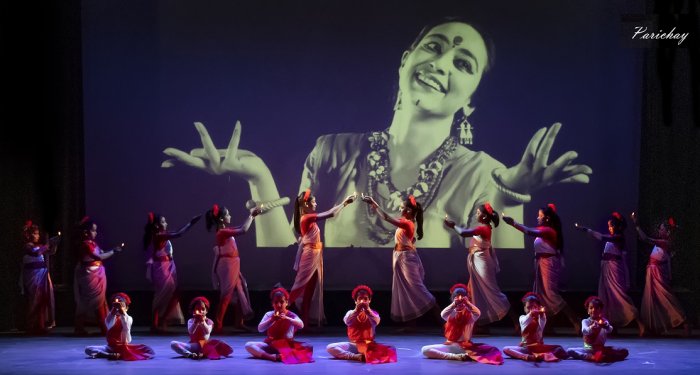 Tamiswaranang 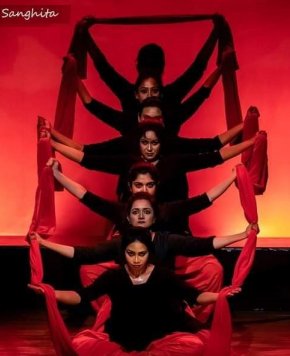  Aami
Presented by Dancers' Guild - Manjushri's institution -- on March 28, Ranjabatir Janye (for Ranjabati), to commemorate the latter's birthday, was a breath of fresh air, happening after a long time. The program began with an Upanishadic hymn Tamiswaranang - chanted by the recorded voice of the iconic Bengali singer Debabrata Biswas - to which a large number of junior artists of Dancers' Guild traipsed with enthusiasm, with burning lamps in hand. The idea was to visualize a transition from darkness to illumination, also from untruth to palpable honesty as well as from death to immortality. The little dancers made multiple patterns on the stage and created waves and arcs in an enticing manner. Next was Aami (Myself), the journey of a girl and her struggles, performed by members of Dancers' Guild. Choreographed by Mithun Banerjee, a performing artist of the Guild, it was a major foray into burning women's issues, supported by audio-visuals on the cyclorama. For instance, it made the telling points that daily 2000 girls' embryos are destroyed in the mothers' womb; in a single year, 12 million minor girls are married off and driven into premature conceiving of babies, post-marriage; 6 to 8 lakhs of women are trafficked every year for prostitution all over the world; and in India alone, daily 156 women are raped. The passions, the futile struggles and the sufferings came out in beautifully etched body-arches, desperate bonding and dragging unwilling torsos on the bare floors created new kinds of patterns and evolved a linguistic paradigm all its own, to depict anguish, frustration, torture and an utter loss of all human values. It was seen, for a change, how the narrative structure of Nabanritya could rise to the occasion, namely, femininity's ultimate indignation, to create both pathos and silence, to bring out living hell within an erstwhile happy space. Angikam presented next by Nrityalok, had 13 dancers depicting abhinaya hastas and their applications in Bharatanatyam style. Cokpetentlu directed by Sutapa Awon Pradhan, was a long-drawn exercise and, although very sincere in its efforts, seemed a little overdrawn. Music by Srijan Sircar and Debarghya Das was adequately supportive. 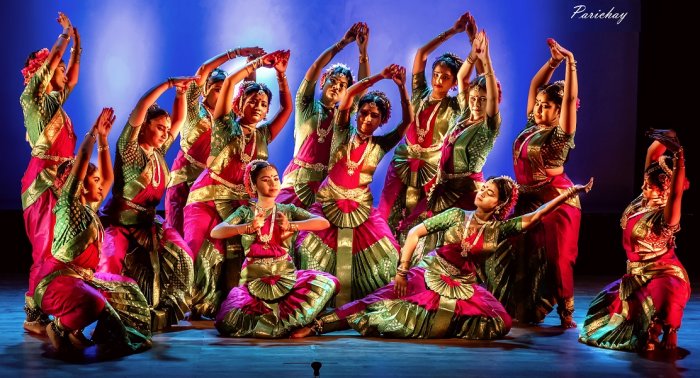 Angikam 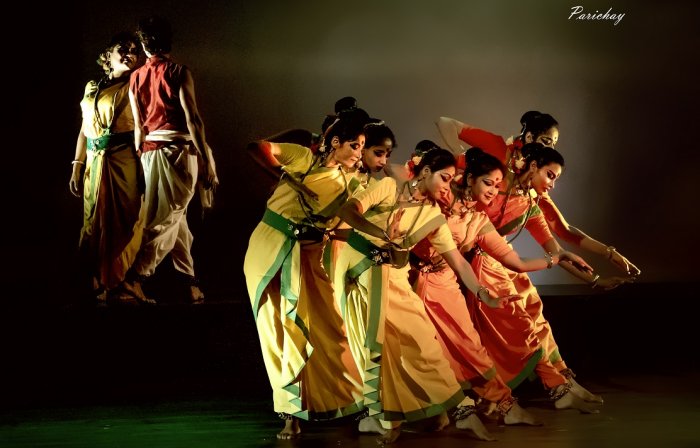 Ananda Basanta Samagame Ananda Basanta Samagame (At the Advent of the Vernal Joy) was the grand finale presented by Dancers' Guild with all their senior dancers. A seasonal ode to spring - originally created by Manjushri -- it was directed by Jonaki Sircar. Strung to a bouquet of exhilarating Tagore songs on spring, the attempt seemed to concentrate on Nabanritya's kind of choreography and avoid Santiniketan's clichéd style. Starting with the inevitable: Open the doors, you householders, it is the colours outside.., the sequel went on to: O the flowers of Shirish and Bakul, O the wilderness of Sal and Piyal; the tender temerity of: It is the least of touches, the barest syllables of talk...; the boisterous, all-pervading: Come up, one and all, who will give up everything..; the Carnatic tremulous melody of Basanti, the world-enchantress...; the sincere appeal to the spring breeze: Blow slowly, O the listless wind..., punched with: Wake up, O the southern storm...; the slow and ponderous: O moon, who would cradle you and rock you to and fro...; the season's intimation: O my brothers, it is the touch of spring in the woods, the blossoms and the quivering leaves...; and the final fulfillment: O the soul is brimful of grace. The matching mood of the dance kept varying from highly stylized to a throw-away folksiness, back to a wonderfully disciplined group composition, again prepared to break asunder... Dreams with Wings 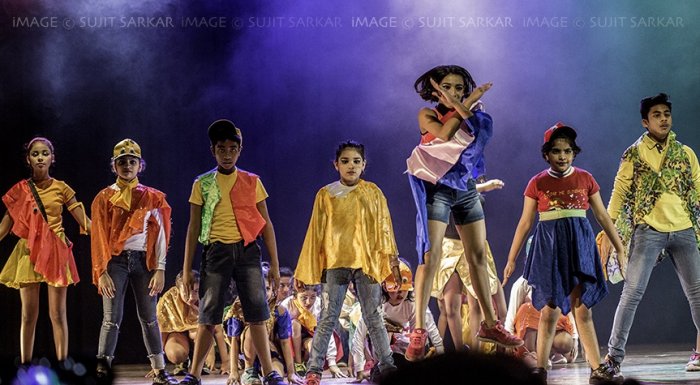 Dreaming of color & vibrance 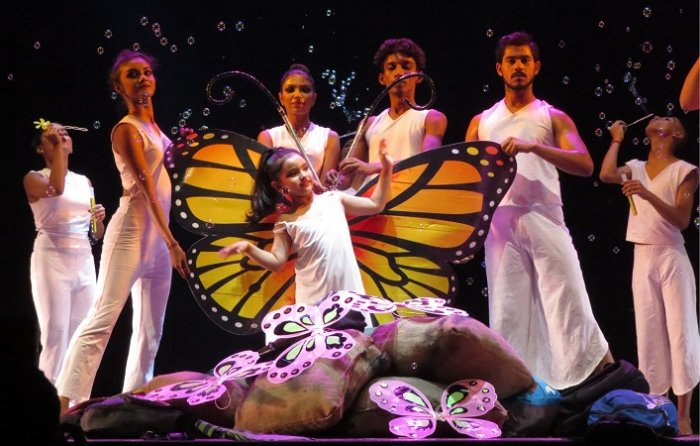 Let me fly  Thrust into the rat race How does one view the transition from wide-eyed innocence of childhood to the complexities and paradoxes of an adult world with its own follies and frustrations? What are the models available? Looking to the Western paradigm, once the children cross the 16-year-old barrier, they are very consciously allowed to "break the shackles of parental bondage" and encouraged to "go out in the wide open world" with a total sense of independence as well as choices of lifestyle and livelihood. In a 180-degree paradigm shift, the Indian child is quite often "protected", "guided" or "chaperoned" - use whichever phrase one would wish. Indeed, the child is given hand-holding as long as s/he wishes to have and, worse, often treated as the means to fulfill what the parental aspirations could not achieve in their own lifetime. Is that the right choice? Presented on March 31, Dream without wings at the Sapphire Annual Gala 2019, by the Sapphire Creations Dance Troupe and Sapphire Dance Academy, was an extravaganza, performed by some 50 dancers - spanning the age groups between 4 to 45 years - to tell the story of our children and what they aspire to be. Directed by Sudarshan Chakravorty, who has led Sapphire for all 26 years, the choreography was cascaded - in age -- from the younger lots to the gradually older ones, till one arrived at the professional company, who backed up to provide the "mirror image" of what the toddler alongside wanted to become -- or was it not to become? -- and be fulfilled, or frustrated, as the case might be. The performance had several distinctive features. First, it was portrayal of paradoxes, while the joy of innocence was writ large on the participants, especially in the younger segments, the competitive elements were injected early in life by the elders, as reflected in the choreography. Second, the youngsters were looking at themselves constantly: did they have social approval in what they were achieving and how they were progressing in life? Third, the metaphors of scintillating success and dismal failures were continuously evaluated and reinforced by repetitive dance movements. Fourth, emotions like aggression, nostalgia, loss of innocence were played up and made palpable. Perhaps best termed as a "psycho-drama", Dreams with Wings had many visually compelling moments. The back-breaking load of study material stunting growth; the fluttering wings of the beaming little butterfly-girl cheered by an appreciative crowd; the grown-up seniors carrying the aspiring tiny tots on the back and romping along; and much mood-playing stood out. Above all, the sheer joy of the little ones matching steps and trying out ballet-like steps - without faltering once! -- was quite infectious. The scene where the stage was swathed by floating bubble gums sparkling in the light and children danced wrapped by the shimmering glow was particularly captivating. The only jarring factor was the minimalist music - generally quite supportive - being suddenly punctuated by popular Bengali band doggerel: Have milk, otherwise you won't be a good boy... and was uncalled for. 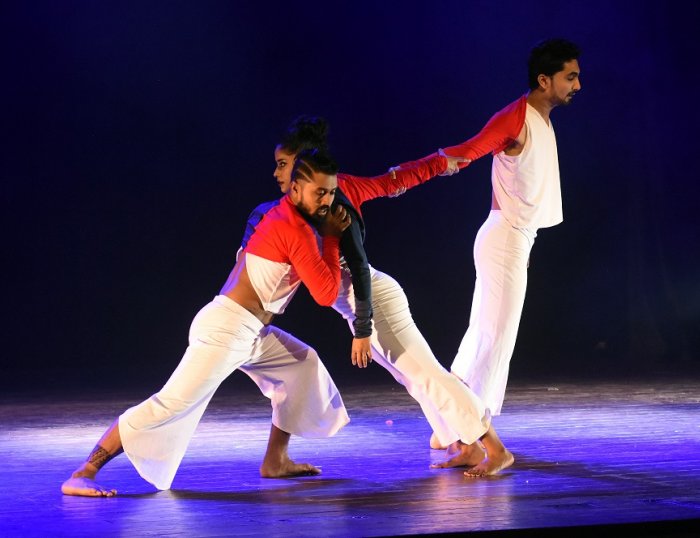 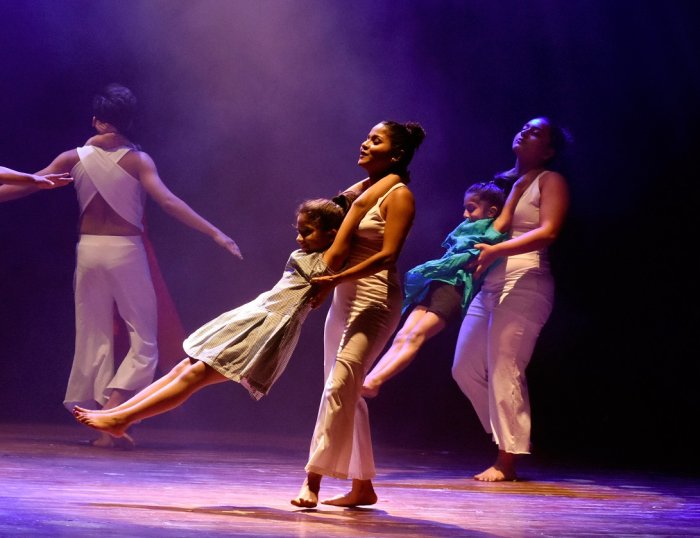
Dance sequel Extracts from interview with the director: Ruminating over your own early days, how would you view childhood that you depict? It is literally the story of transformation from a caterpillar to a butterfly. I sincerely believe that each child has a butterfly within, who wants to unfold its colorful wings and fly in an open blue sky. Our production invokes this very spirit of freedom to allow the children to fly without fear and lead their life on their own terms. Let them be what they really aspire for... Right, but how did you relate this to the current, social milieu? It's the bitter truth of our times that children bend down to the wishes, demands and preoccupations of the family and society. Burdened by an education system that teaches us to "blend in" and not "stand out", where we study to get grades and not acquire true knowledge. Children eventually forget their inner urges and "arrive" at the end of their education, into a rat race of mundane achievements that makes them too busy and too tired, all too soon. They forget their real identity, their dreams, their place in this country and the world, as a human being committed to contributing to the betterment of mankind. Don't you agree? How did you come upon the idea of Dreams with Wings? As our 26 years drew to an end, we went back to the beginning, where it all started. We pondered on the basic question: how many of us - artistes -- could recount a smooth growth of our artistic career, replete with encouragement and support from our parents, family and society? On the contrary, how many of us knew people who sneered and asked us what our real job was, once they heard that we sing or dance or paint or write...? What was the final structure you arrived at? We thought of our annual gala show, this time, in terms of a combined effort of our Academy / Playgroup, Academy / Seniors, Interns and Company -- a very large group indeed - to join hands and bring an exploration of who our children were, what their dreams were, and how often they were forced to forget them. We also wanted the story to unfold through music, songs and lots and lots of movements in around 70 minutes...  Dr. Utpal K Banerjee is a scholar-commentator on performing arts over last four decades. He has authored 23 books on Indian art and culture, and 10 on Tagore studies. He served IGNCA as National Project Director, was a Tagore Research Scholar and is recipient of Padma Shri. Post your comments Please provide your name and email id when you use the Anonymous profile in the blog to post a comment. All appropriate comments posted with name & email id in the blog will also be featured in the site. |